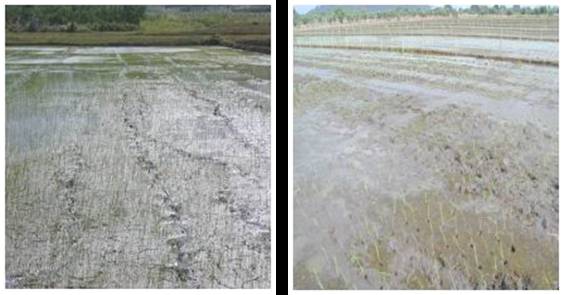|
|
|
Planting the rice |
|
||
|
|
|
|
|
||
|
|
|
Environmental conditions that affect seed establishment |
|
||
|
|
|
|
|
||
|
|
|
Describe how environmental conditions should be to have good seed establishment |
|
||
|
|
|
What happens with a seedling when it grows?
|
|
||
|
|
|
What does a seedling need to grow?
Some environmental conditions have an influence on the seedling’s growth:
1. Seed soil contact To begin the germination process, the seed absorbs moisture from its surroundings. In a dry seed bed, absorption occurs after seed distribution through contact with moist soil or submergence in water.
For seeds to make good contact with the soil, soil peds (clods) need to be similar in size to the seed. Seed soaking or seed priming prior to planting speeds up the absorption process and is often used to increase the rate of plant establishment.
The soil clods need to have a similar size as the seed in order to make good contact
|
|
||
|
|
|
2. Seed placement Rice seeds must be placed close to the soil surface.
When dry seeding into heavier clay soils, place seeds within 10 to 15 mm of the surface. If seeds are placed at depths greater than this, surface sealing will restrict the number of shoots that emerge and increase the time to emergence. When wet seeding, seeds should not sink below the puddled surface. Where possible the water is allowed to partially clear before seeding. This may require waiting for up to 48 hours after puddling.
|
|
||
|
|
|
3. Soil insects and disease Plant establishment can be slowed down by the following soil borne insects: nematodes, crickets and wireworms.
Some of these problems can be solved by cultural controls: crop rotation, trap crops, and bare fallowing. Seed dressing protects the seed from insects that directly attack the seed. For stem and root protection, it is necessary to use the appropriate pesticide through surface application or soil fumigation.
Pesticide application |
|
||
|
|
|
What planting techniques can you use best?
The most suitable planting technique depends on locality, soil type, and crop ecosystem.
Crops can be direct seeded or transplanted. Transplanted crops can be established manually or by machine. Direct seeded crops tend to mature faster than transplanted crops but have more competition from weeds.
Direct seeded (left) and transplanted crop (right) |
|
||
|
|
|
|
|
||
|
|
|
|
|
||
Next lesson |
|
Let's have a better look at these planting techniques. First 'direct seeding'. |
|

![obj[1]](obj_1_.gif)


